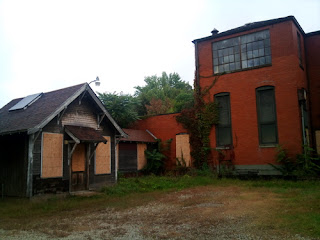 |
| Page and monarch forth they went, Forth they went together; Through the rude winds wild lament, And the bitter weather. |
On my perfect December day, something roasts in the oven, an old phonograph spins, candles cast amber light. It is a month for looking in and holding close. A month, as the old Advent carol implores, to trim the hearth and set the table.
But on Boxing Day, on this year the Monday after Christmas, the vineyard beckons. I rouse myself from a slumber fueled by buttery treats and amber ales. Every bone aches to not leave the warmth of home, to not venture south on the road to Canton.
The work this day is drudgery, mounding soil up around protective plastic sleeves I have placed around tender one-year vines. This warm and soggy autumn and winter have left the soil workable even at this late date. The rhythm of spade to soil, the clink of metal on field stone, the tenacious grasp of clover roots.
Plant by plant. Row by row. Slow, deliberate work. Eyes to the ground. Frost tinged clover leaves, clumps of soil. Dig. Churn. Thrust. Mound.
But shovel work is satisfying work. The sound of the spade cutting through turf. The pleasant earthy smell. Wriggling earthworms even still. The soil is alive, and varied, as I cut across the sloping south vineyard: here clay and waterlogged, there sandy and flecked with smooth river pebbles.
It's the desperate honking of geese, however, that casts my eyes toward the sky. They settle into a perfect vanguard just as they pass overhead. I wonder if they are heading south in a hurry, perhaps realizing this balmy December has bid them stay too long.
Even after the noisy gaggle settles into a silent and perfect wedge across the sky, my eyes linger on the eastern horizon. It is startlingly cerulean, flecked with wisps of cirrus clouds. The words of the old advent carol echo cannily:
People look east, the time is near
Of the crowning of the year
In a month of pulling in and holding close, this is a day to look out. That's what the good king did on this day, which is also the Feast of Stephen. But while he gazed upon snow, crisp and clear and even, I gaze upon a sloping vineyard planted in a field of clover, with a bright meridian sun casting long shadows.
I look out on gold tipped willow branches cast in sharp contrast to a bright blue sky.
I look out on yellow gables of the old farmhouse against a blue backdrop enlivened by fast floating puffs of white.
I look out on a crested blue heron taking wing from the marsh, rising from tawny grasses and red stemmed branches.
I look out on gently rippling lake waters.
I look out on the old tracks heading south to Canton, and know that once the four o'clock train rumbles by, this brilliant sky, and this startling day, will have passed.
I am thankful for this sky and this vineyard to tend, and these old songs that rattle around my noggin. December often casts a melancholy pall, and sometimes a leaden sky settles overhead around Veterans Day and lingers to well past Easter.
But this winter there have been days of bright sunshine, with the long shadows December casts even at noon.
And I think of Stephen, whose feast is this day, and who at the darkest hour, looked up, and saw the heavens open.
 |
| Annibale Carracci The Martyrdom of St Stephen 1603-04 - Oil on canvas Musée du Louvre, Paris |
A Boxing Day of startling cerulean skies and gently rippling lake waters. A Feast of Stephen that brought me reluctantly out to tend these vines, and rewarded me with a magnificent sky.
All we have to do is remember to look up, and look out, and whether the sky be leaden and the ground sodden, or the horizon brilliant and the clover sweet underfoot, know that eventually the cruel frost and bitter weather of the good king's carol will find us.
But we will take these startling days, and these cerulean skies, and they will become the warm footsteps through the sod, the food and wine we will summon, the pine logs that will warm us, against that cruel weather, which will surely come.
In his master’s steps he trod, where the snow lay dinted;
Heat was in the very sod which the saint had printed.
That is what Boxing Day reminds us, to not just hunker down, but to look out, and up, with gratitude and charity, to make a feast of whatever it is that comes to us, however meager it may seem, knowing that sometimes a heron taking sudden flight from a marsh of brittle grasses may be enough bounty for one day.


















































